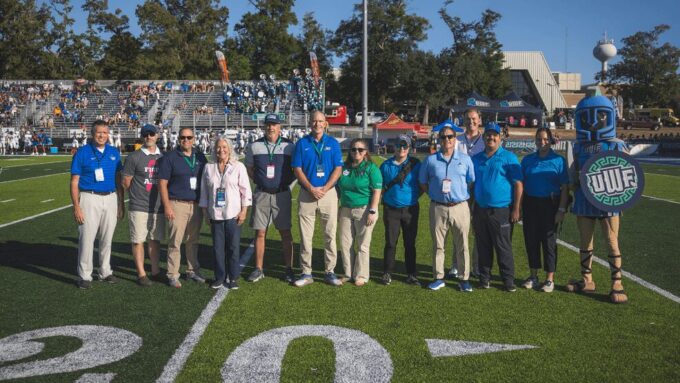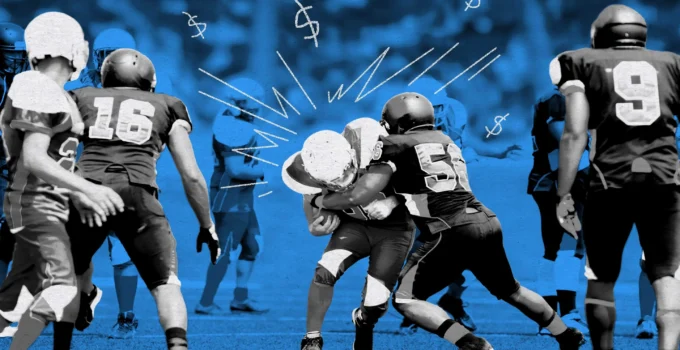Have you ever wondered how a Saturday afternoon game can generate the kind of revenue that rivals Fortune 500 companies?
What started as a showcase of school pride has evolved into an empire with massive TV deals, powerhouse endorsements, and jaw-dropping financial figures. Let’s peel back the curtain and see how it all adds up.
Key Points:
- TV deals are the driving force behind revenue.
- Sponsorships and donor contributions fuel growth.
- Athlete endorsements add new revenue streams.
- Facilities and branding are key investments.
- The NIL era has redefined athlete value.
The Rise of Athletic Donations and High-Stakes Fundraising

Source: weartv.com
Collegiate athletic programs aren’t just funded by ticket sales. They thrive on massive donations that shape their future. Take SMU, for example. Their recent achievement of surpassing a $125 million goal for the ACC Competitiveness Campaign is a perfect case. Matthew H. Fleeger played a key role with a $2 million commitment, boosting the program’s ability to compete at the highest level. Donations like this aren’t just generous; they’re strategic investments in a program’s future success.
Donors are often alumni or local business leaders with deep connections to the university. Their contributions fund scholarships, facility upgrades, and even coaching staff salaries. The influence of such donors can’t be understated, as they often help shape the direction of entire athletic departments. It’s not just about giving back; it’s about leaving a legacy tied to athletic excellence.
The Power of Television Contracts
Television contracts are the backbone of revenue for major athletic conferences. Networks battle for broadcasting rights, shelling out billions to secure exclusive deals. This isn’t about tradition; it’s about ratings. More viewers mean more advertising dollars, and conferences know their value. The SEC and Big Ten have redefined the landscape, signing deals that would make even professional leagues envious.
TV networks crave live events because they’re DVR-proof and perfect for real-time engagement. This has led to skyrocketing bidding wars for rights to air games. The exposure benefits both the networks and the schools, as it attracts recruits, boosts merchandise sales, and increases national recognition. The financial impact is staggering, with some contracts exceeding a billion dollars annually.
The NIL Revolution: Athletes as Brands

Source: visionfactory.org
The Name, Image, and Likeness (NIL) era has flipped the script. Athletes can now profit directly from endorsements, social media, and personal branding. This shift doesn’t just benefit players; it attracts more sponsors, increases media attention, and elevates the overall financial stakes. Universities indirectly profit through heightened exposure and recruitment advantages.
Athletes are now mini-corporations, negotiating deals with brands ranging from local car dealerships to global apparel giants. The ability to monetize personal brands has led to a more competitive environment, not just on the field but in the business world. Schools that support their athletes in navigating NIL opportunities gain a competitive edge in recruiting top talent.
Facilities Arms Race: More Than Just Locker Rooms
Forget simple gyms. We’re talking about multimillion-dollar complexes with state-of-the-art technology, luxury amenities, and jaw-dropping architectural designs. Schools invest heavily to attract top recruits and impress donors. It’s not just about functionality; it’s about making a statement.
The competition to build the best facilities has turned into an arms race. Schools showcase high-tech training equipment, recovery suites, and even barber shops and gaming lounges. The goal is to create an environment that not only develops elite athletes but also enhances their quality of life. This investment pays off in recruitment success and athlete performance, creating a cycle of sustained excellence.
Sponsorship Deals That Rival Pro Sports
Corporate sponsorships are another revenue giant. From Nike and Adidas outfitting teams to local businesses securing advertising space, partnerships inject cash into programs. The bigger the brand, the bigger the check. This symbiotic relationship enhances visibility for companies while funding athletic excellence.
Sponsors seek exposure to the passionate fan base that collegiate athletics offers. This leads to naming rights for stadiums, branded apparel, and even sponsored game segments. The financial benefits flow both ways, as companies gain loyal customers and schools secure essential funding for athletic programs.
Ticket Sales and Merchandising: The Traditional Giants
Despite the digital age, ticket sales and merchandise remain crucial. Rivalry games, bowl appearances, and March Madness generate massive ticket revenues. Add in merchandise—jerseys, hats, and everything in between—and you’ve got another solid revenue stream.
Game day experiences drive ticket sales, with fans eager to be part of the live atmosphere. Merchandise sales extend beyond campus, with online platforms reaching a global audience. Limited edition items, retro gear, and player-specific merchandise create a continuous demand, turning fans into walking advertisements.
Social Media and Digital Influence

Source: online.maryville.edu
Social media platforms aren’t just for fans to cheer; they’re monetization goldmines. Universities leverage massive followings for sponsored content, advertising partnerships, and exclusive digital content subscriptions. It’s a modern twist on fan engagement that comes with serious financial perks.
Athletic departments invest in social media strategies to maximize engagement and revenue. Live updates, behind-the-scenes content, and interactive campaigns attract followers and sponsors alike. The digital footprint of a program can significantly impact its brand value and financial success.
The Impact of Conference Realignment
Conference realignment isn’t just about geography. It’s a strategic move driven by financial incentives. Schools jump conferences to secure better TV deals, stronger competition, and increased exposure. The ripple effect influences recruiting, sponsorships, and revenue distribution.
Realignment decisions often hinge on potential revenue increases. Joining a more lucrative conference can lead to larger media rights payouts, better bowl game opportunities, and enhanced recruiting power. The financial implications are profound, reshaping the landscape of collegiate athletics.
The Role of Coaching Salaries and Contracts
Coaching salaries have skyrocketed, reflecting the business side of collegiate athletics. Top coaches command multimillion-dollar contracts, often with lucrative bonuses tied to performance. These investments are justified by the revenue generated through winning programs.
Coaches are not just strategists; they’re CEOs of their programs. Their leadership impacts ticket sales, merchandise revenue, and donor contributions. Successful coaches attract top talent, media attention, and financial support, making their salaries a critical investment for athletic departments.
Bold Predictions for the Future
- Athletic Departments Becoming Media Powerhouses: Expect schools to create their own streaming networks.
- Increased Globalization: International games and global recruitment will expand the audience base.
- Dynamic Ticket Pricing Models: Similar to airlines, ticket prices will fluctuate based on demand and performance.
The future of collegiate athletics will be shaped by innovation and adaptability. Schools that embrace new revenue streams, invest in technology, and support athlete branding will lead the way.
The Bottom Line
Athletics are no longer just a campus activity; they are economic juggernauts. The blend of tradition, competition, and strategic business moves creates an industry that continues to grow. As fans cheer for touchdowns and buzzer-beaters, the real game—the business game—is just as thrilling.







